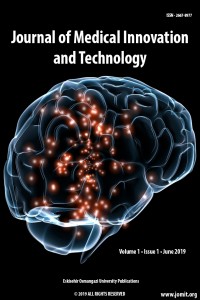Abstract
Craniosynostosis is the closure of one or more of the skull sutures before the normal process. The main complications of craniosynostosis surgery reported throughout history; excessive blood loss and transfusion-related reactions, long hospital stay times, length of surgery and perioperative causes of infections, cerebrospinal fluid leaks, dural sinus injuries and calvarial bone deformities as a result of clinical findings since ancient times, although modern surgical treatment methods was carried out in the last century. The aim of surgery for single suture craniocinostosis is to prevent intracranial pressure increase, hydrocephalus, visual disturbances, cognitive retardation and poor aesthetic appearance by eliminating the shape adjustment disorder of the cranium and brain. One of the popular innovations of our day, 3D printers are used more and more in medicine as in every field of life. Thanks to these printers, the symmetrical structure is preserved and a better appearance is obtained from the cosmetic perspective. In terms of usage, there are no significant differences between them. The surgeon's decision on the type of material to be used during surgery and which one is appropriate is important. Using these new generation printers with complex computer programs and production techniques and production techniques, it is possible to reproduce various types of tissue with different texture processing properties.
Keywords
References
- 1. Wurm G, Lehner M, Tomancok B, Kleiser R, Nussbaumer K: Cerebrovascular biomodeling for aneurysm surgery: Simulation-based training by means of rapid prototyping technologies. Surg Innov 18:294–306, 2011
- 2. Tai BL, Rooney D, Stephenson F, Liao P, Sagher O, Shih AJ, et al: Development of a 3D-printed external ventricular drain placement simulator: Technical note. J Neurosurg 123:1–7, 2015
- 3. LoPresti M, Daniels B, Buchanan EP, Monson L, Lam S. Virtual surgical planning and 3D printing in repeat calvarial vault reconstruction for craniosynostosis: technical note. J Neurosurg Pediatr 2017; 19: 490–4.
- 4. Jiménez Ormabera B, Díez Valle R, Zaratiegui Fernández J, Llorente Ortega M, Unamuno Iñurritegui X, Tejada Solís S. 3D printing in neurosurgery: a specific model for patients with craniosynostosis. Neurocirugia (Astur) 2017;28(6):260–265
- 5. Jimenez DF, Barone CM: Multiple-suture nonsyndromic craniosynostosis: Early and effective management using endoscopic techniques. Clinical article. J Neurosurg Pediatr 5: 223–231, 2010
- 6. Tunçbilek G, Vargel I, Erdem A, Mavili ME, Benli K, Erk Y: Blood loss and transfusion rates during repair of craniofacial deformities. J Craniofac Surg 16:59–62, 2005
- 7. David L, Glazier S, Pyle J, Thompson J, Argenta L: Classification system for sagittal craniosynostosis. J Craniofac Surg 20(2):279-282, 2009
- 8. Di Rocco F, Arnaud E, Renier D: Evolution in the frequency of nonsyndromic craniosynostosis. J Neurosurg Pediatr 4(1):21- 25, 2009
- 9. Provaggi E, Leong JJH, Kalaskar DM: Applications of 3D printing in the management of severe spinal conditions. Proc Inst Mech Eng H 231(6):471-486, 2017
- 10. Kim JC, Hong IP: Split-rib cranioplasty using a patient-specific three-dimensional printing model. Arch Plast Surg 43(4):379– 381, 2016
Abstract
Keywords
References
- 1. Wurm G, Lehner M, Tomancok B, Kleiser R, Nussbaumer K: Cerebrovascular biomodeling for aneurysm surgery: Simulation-based training by means of rapid prototyping technologies. Surg Innov 18:294–306, 2011
- 2. Tai BL, Rooney D, Stephenson F, Liao P, Sagher O, Shih AJ, et al: Development of a 3D-printed external ventricular drain placement simulator: Technical note. J Neurosurg 123:1–7, 2015
- 3. LoPresti M, Daniels B, Buchanan EP, Monson L, Lam S. Virtual surgical planning and 3D printing in repeat calvarial vault reconstruction for craniosynostosis: technical note. J Neurosurg Pediatr 2017; 19: 490–4.
- 4. Jiménez Ormabera B, Díez Valle R, Zaratiegui Fernández J, Llorente Ortega M, Unamuno Iñurritegui X, Tejada Solís S. 3D printing in neurosurgery: a specific model for patients with craniosynostosis. Neurocirugia (Astur) 2017;28(6):260–265
- 5. Jimenez DF, Barone CM: Multiple-suture nonsyndromic craniosynostosis: Early and effective management using endoscopic techniques. Clinical article. J Neurosurg Pediatr 5: 223–231, 2010
- 6. Tunçbilek G, Vargel I, Erdem A, Mavili ME, Benli K, Erk Y: Blood loss and transfusion rates during repair of craniofacial deformities. J Craniofac Surg 16:59–62, 2005
- 7. David L, Glazier S, Pyle J, Thompson J, Argenta L: Classification system for sagittal craniosynostosis. J Craniofac Surg 20(2):279-282, 2009
- 8. Di Rocco F, Arnaud E, Renier D: Evolution in the frequency of nonsyndromic craniosynostosis. J Neurosurg Pediatr 4(1):21- 25, 2009
- 9. Provaggi E, Leong JJH, Kalaskar DM: Applications of 3D printing in the management of severe spinal conditions. Proc Inst Mech Eng H 231(6):471-486, 2017
- 10. Kim JC, Hong IP: Split-rib cranioplasty using a patient-specific three-dimensional printing model. Arch Plast Surg 43(4):379– 381, 2016
Details
| Primary Language | English |
|---|---|
| Subjects | Surgery |
| Journal Section | Research Articles |
| Authors | |
| Publication Date | June 17, 2019 |
| Published in Issue | Year 2019 Volume: 1 Issue: 1 |


